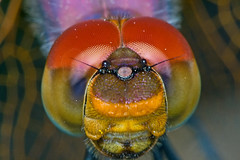The Internet is filled with a lot of wonderful things. Unfortunately it’s also filled with a lot of misinformation. You’ll hear people claim that some lenses are better than others due to the working distance, and how one lens is a better “bug lens” than another because the working distance is better. Well, I’ve only been shooting macro for a year and a half but I’ve already learned one important aspect about shooting insects. Critters fall into two distinct categories:
Those that will let you get close and those that won’t…
It really doesn’t matter what macro lens you have attached to your camera. If an insect stays put, then it will let you get close and you’ll take a picture of it -period. The lens, and the gear in general, does not decide how close you can get –the insect does. Now you might find it easier to work with a 100mm lens over a 60mm simply because you’ve got more room to maneuver with the longer lens. But shooting with a long focal length macro lens will not guarantee close shots of anything.
You’re skill at getting close is what counts.
Take the head shot that’s included with this post. I saw several dragonflies that day, but few would let me get next to them. But I know from experience what to look for and when I spotted one feeding from a perch I tried my luck. I got the full body shot that I wanted, so I backed up and added 62mm of extension tubes to my Canon 100mm macro and the 500D diopter (it was already on the lens) for about three times life size magnification. This dragonfly really liked that perch –he was hunting bees from it and if you look closely at the whiskers you’ll see pollen stuck in them (click on the photo for a larger image). So I knew I could get close and the working distance of my 3x rig, 9cm (about 3.5 inches), made no difference. I know several shooters who are taking insect shots at life size and higher magnification with Canon’s EF-S 60mm lens and it has a working distance of less than 4 inches (about 10cm).
It’s not the gear that makes the difference –it’s you…


6 comments:
Could you comment here or in a new post, about the equipment you are using. More specifically, I'm trying to understand the use of the extension tubes and what they actually do. I have the same Canon 100mm lens and while skill and technique are critical, I am curious about the equipment you are using. Maybe even a photo of your "usual" macro setup.
Thanks for the wonderful site!
I've been meaning to do a "gear that I use post" -I'll move that one to the top of the list since you asked for it. As for the extension tubes: They just increase the magnification by getting the lens farther away from the sensor (imagine the image circle that the lens projects getting bigger as the lens moves further away from the sensor plane).
There's a link in the Articles section to Mark Plonsky's web site and he explains what a lot of the accessories do.
Good point, i´m used to work with 3-4cm distance with my 44mm lens and its ok for me
but i think people says that bigger distances are better mostly because of lighting
Thanks for the post Tech!
The only reason I can think of for using a longer lens is to prevent casting a shadow over the critter -but even that can be solved by changing the angle that you're shooting from.
Thanks a lot for this post.
I'm using Olympus Zuiko Digital 35 macro and I have been worrying about that I have missed a lot of insect shots because of the short length.
Instead of spending my money on a longer lens I will use them on a better flash :)
Learning how to control the light in your shots is a lot more important than working distance...
Post a Comment